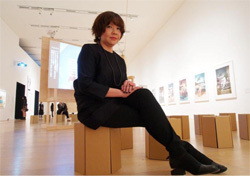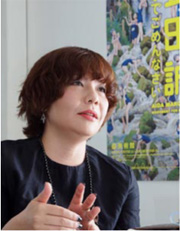Home > Highlighting JAPAN > Highlighting Japan NOVEMBER 2012 > A Bridge Between Art and Society
Highlighting JAPAN
[SERIES] Yamato Nadeshiko
A Bridge Between Art and Society
A curator plans exhibitions, brings together the works to exhibit, and decides the order and method of displaying the works. To sum up, it is no exaggeration to say that an exhibition is a performance by a curator. Mami Kataoka, chief curator at the Mori Art Museum in Roppongi, Tokyo, curates exhibitions of contemporary art, not only in Japan, but all over the world including Asia, Europe, and the United States. She was also chosen as one of six Asian women to act as co-artistic directors for the Gwangju Biennale being held in Korea until November 11. Osamu Sawaji of the Japan Journal speaks with Kataoka.

Mami Kataoka at the Arab Express exhibition held at Mori Art Museum until October 28. The museum welcomes 1.5 million visitors every year. It is open every day until 10 p.m. (until 7 p.m. on Tuesdays only).
Credit: TADASHI AIZAWA
Why did you not choose the path of an artist in the art world?
Mami Kataoka: When I was a child, my mother used to show me picture books and books of paintings at home and I liked looking at the pictures. In junior and senior high school I studied oil painting on my own, but from junior high to university, I was more interested in handball. I studied fine arts at university because I was interested in art, but I never thought about becoming an artist. When I majored in pottery at university, I realized that I would have to focus 100% on the clay, the raw material for pottery, and on the glaze, or the firing process, to be able to create the kinds of pieces I had in mind. Then, I thought I was not ready to go the distance to create works of art.
What made you aspire to be a curator?
When I was at university, I studied art on an exchange program in Pennsylvania in the United States. In my free time I often visited art galleries and museums in New York where I encountered twentieth-century American contemporary art by Jasper Johns, Andy Warhol and others. That's when I learned that contemporary art has the power to change society by making statements about reality, or by alerting people to completely different values. I became interested in trying to give new awareness by becoming an intermediary between contemporary art and society, rather than expressing myself as an artist.
First, you worked as the curator of the art gallery at the Tokyo Opera City complex in Shinjuku, Tokyo, from 1997.
Since 1992, a few years before Tokyo Opera City opened its doors, I had worked at a think tank where I was involved in preparing for the opening of the Tokyo Opera City Art Gallery. I had a strong sense that Japan needs a place where Japanese contemporary art is exhibited and where international art movements are introduced that were not inferior even by international standards. Several major corporations were involved in the construction of Tokyo Opera City. At the time, I was still in my late twenties and I was the only woman in the group, but I discussed with male counterparts who were much older than me about how the space for contemporary art in Tokyo should be. I think this is how I ended up choosing the path of a curator.

Mami Kataoka. A poster for the Makoto Aida exhibition, which opens on November 17, is displayed on the wall in the background.
Credit: TADASHI AIZAWA
In 2003 you became curator at Mori Art Museum. What is the thinking behind your work there?
The Mori Art Museum aims to be a hub for Asian contemporary art and organizes international exhibitions primarily focusing on Japanese and Asian artists. You could say that the exhibitions are an expression of my inquisitive mind. Every time I curate an exhibition I try to find some solution to my own doubts and issues. For example, how to promote Japanese artists internationally is one of my main issues. I think the attraction of Japan is its multifaceted nature. There is the traditional art on one hand, but there is also anime and the latest technologies on the other. Today, I am attempting to analyze the multifaceted nature of Japan by making analogies to the artistic practice of an artist named Makoto Aida. Makoto Aida is popular in Japan, but he is not particularly appreciated overseas, not like Yoshitomo Nara or Takashi Murakami. From November 17, we will be holding an exhibition titled "Aida Makoto: Monument for Nothing" at the Mori Art Museum, but the question is can a domestic artist find an international following.
What do you do for relaxation?
I cook. Cooking is a bit like working as a curator because there is the fun of creating delicious food by combining unexpected ingredients. When I am in Japan, I cook dinner nearly every night.
© 2009 Cabinet Office, Government of Japan






